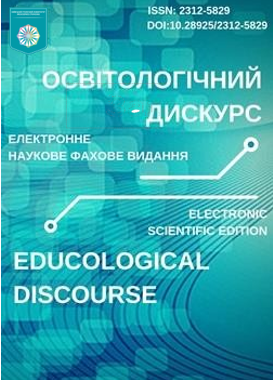The Use of Artificial Intelligence Chatbots in Teaching Foreign Languages as an Innovative Interactive Technology
DOI:
https://doi.org/10.28925/2312-5829.2024.2.2Keywords:
chatbot, artificial intelligence, foreign language teaching, innovative technology, interactive technologyAbstract
The article explores the didactic potential of the use of artificial intelligence technologies, specifically chatbots, in teaching foreign languages. It delves into the advantages of integrating chatbots into the foreign language learning process, based on the experience of teaching the “Foreign Language (English)” discipline to the first-year students of the 024 Choreography speciality of the Faculty of Musical Art and Choreography, and the 022 Design speciality of the Faculty of Fine Arts and Design at Borys Grinchenko Kyiv Metropolitan University. While highlighting the educational benefits and interactive nature of chatbots, it also addresses their drawbacks and suggests methods to mitigate potential negative consequences such as academic integrity violations and copyright issues like plagiarism. The article offers advice on appropriate usage and adheres to relevant policies. Moreover, it provides practical examples of using chatbots in teaching foreign languages based on the use of Mizou software. The study is a theoretical research article employing general scientific analytic methods such as synthesis, generalization, and systematization. It includes a review of the related literature on the stated problem as well as an overview of the empirical experience of the introduction of chatbots in the “Foreign Language (English)” discipline. The paper defines the didactic potential of the Mizou by providing a general overview of the functions and modes of the aforementioned software and drives a reader through the personalized chatbot process of creation and customization. The provided research highlights the necessity of further investigation of the implementation of artificial intelligence chatbots as an innovative interactive technology with significant didactic potential that should be empirically tested and analysed.
Downloads
References
Baidoo-Anu, D., & Owusu Ansah, L. (2023). Education in the Era of Generative Artificial Intelligence (AI): Understanding the Potential Benefits of ChatGPT in Promoting Teaching and Learning. Journal of AI. 7(1), 52-62. DOI: https://doi.org/10.61969/jai.1337500
European Commission (2021). The Artificial Intelligence Act https://www.euaiact.com/
Feuerriegel, S., Hartmann, J., Janiesch, C., & Zschech, P. (2023). Generative AI. Business & Information Systems Engineering. http://dx.doi.org/10.2139/ssrn.4443189
Fryer, L. K., Ainley, M., Thompson, A., Gibson, A., & Sherlock, Z. (2017). Stimulating and sustaining interest in a language course: An experimental comparison of Chatbot and Human task partners. Computers in Human Behavior, 75, 461–468. https://doi.org/10.1016/j.chb.2017.05.045
Haristiani, N. (2019). Artificial Intelligence (AI) Chatbot as Language Learning Medium: An Inquiry. Journal of Physics: Conference Series, 1387, 1-6. https://doi.org/10.1088/1742-6596/1387/1/012020
Holmes, W., & Tuomi, I. (2022). State of the art and practice in AI in education. European Journal of Education, 57(4), 542-570 https://doi.org/10.1111/ejed.12533
Huang, W., Hew, K.F., & Fryer, L.K. (2021). Chatbots for language learning - Are they really useful? A systematic review of chatbot-supported language learning. J. Comput. Assist. Learn., 38, 237-257. https://doi.org/10.1111/jcal.12610
Karakose, T., & Tülübaş, T. (2023). How Can ChatGPT Facilitate Teaching and Learning: Implications for Contemporary Education. Educational Process: International Journal, 12(4), 7-16. https://doi.org/10.22521/edupij.2023.124.1
Kosharna, N., Petryk, L., Solomakha, A., Sytnyk, O., & Loboda, O. (2023). Digital and multimedia technologies in teaching foreign languages to students of pedagogical specialties. In I. Papadopoulos, & E. Papadopoulou (Eds.), Pedagogical and Research Perspectives on Language Education, New York: NOVA Science Publisher.
Kotenko, O., Kosharna, N., & Holovatenko, T. (2020). Pre-Service Primary School Teacher’s Foreign Language Training by Means of Using Innovative Technologies. In I. Papadopoulos, E. Griva & E. Theodotou (Eds.), International Perspectives on Creativity in the Foreign Language Classrooms, (pp. 257-280). New York: NOVA Science Publisher.
Luo, W., He, H., Liu, j. Berson, I. R., Berson, M. J., Zhou, Y., & Li, H. (2023). Aladdin’s Genie or Pandora’s Box for early childhood education? experts chat on the roles, challenges, and developments of ChatGPT. Early Education and Development, 35(1), 96-113. https://doi.org/10.1080/10409289.2023.2214181
Papadopoulos, I. (2021). Translanguaging as a Pedagogical Practice in Primary Education: Approaching, Managing and Teaching Diverse Classrooms. In I. Papadopoulos, & Sm. Papadopoulou (Eds.) Applied Linguistics Research and Good Practices for Multilingual and Multicultural Classrooms, (pp.147-168). New York: NOVA Science Publisher.
Sharma, P. (2019). Digital Revolution of Education 4.0. International Journal of Engineering and Advanced Technology (IJEAT), 9(2), 3558-3564. https://doi.org/10.35940/ijeat.A1293.129219
Techsence Labs (2022). Advantages and disadvantages of Chatbots. https://techsenselabs.com/learn/advantages-and-disadvantages-of-chatbots/
UNICEF. (2021). Policy guidance on AI for children. https://www.unicef.org/globalinsight/media/2356/file/UNICEF-Global-Insight-policy-guidance-AI-children-2.0-2021.pdf.
Williamson, B. (2023). The Social Life of AI in Education. International Journal of Artificial Intelligence in Education. https://doi.org/10.1007/s40593-023-00342-5
Published
How to Cite
Issue
Section
License
Copyright (c) 2024 Educological discourse

This work is licensed under a Creative Commons Attribution-NonCommercial 4.0 International License.
Автори зберігають за собою всі авторські права та одночасно надають журналу право першої публікації на умовах лізенції Creative Commons Attribution-NonCommercial-ShareAlike 3.0 Unported License, що дозволяє розповсюджувати даний матеріал із зазначенням авторства та первинної публікації в даному журналі.





















